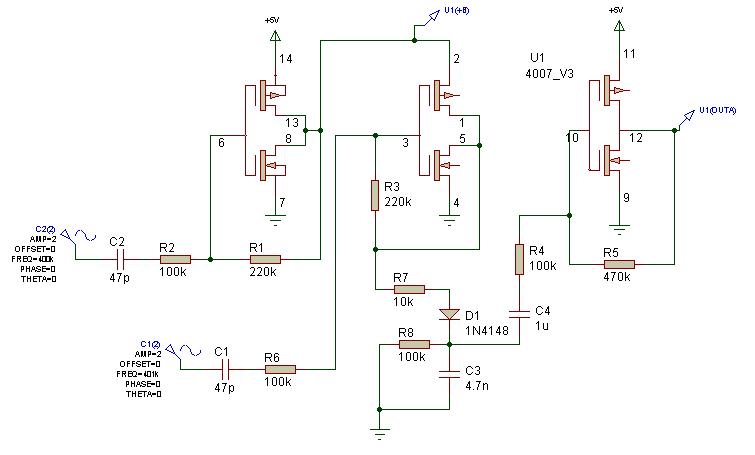Back to crazy CMOS..
The 4007UB still exists! I thought this part went extinct years ago, but its being made in RoHS DIL, and the TI version costs 17p..
Yeah, I loved this chip - and on finding it again, "built" a mixer in simulation.. Ok, this simulation may not be perfect - I used the HCU04 transistor model - but it seems to work beautifully - With a 5V supply and P-P 2V oscillator inputs, there is a lovely sine output at difference frequency - but by changing the signal levels or changing the component values one can get all sorts of distortions.
Nothing below is optimised in any way - just a quick proof of concept.. All the MOSFETS are part of the 4007, and pin numbers are shown (single 4007 used)

The most comprehensive data sheet for the 4007 I have found is this:
http://www.isi.edu/~vernier/EE327/cd4007_intersil_datasheet.pdf
Will perhaps post some waveforms here if anyones interested.
How it works:
First pair of MOSFETs (input on pin 6) act as an inverting amplifier, and amplifies / buffers the first oscillator (say the VFO) - the output of this effectively drives the +V supply pin (pin 2) of a 2nd inverting amplifier / buffer, whose input is the 2nd (say REF) oscillator (input on pin 3)
The output of this stage (pins 1 + 5) is the sum and difference of the two inputs - depending on the drive levels, the degree / depth of modulation (the superimposed difference on the carrier sum) will be determined - if this modulation is not excessive, either the +Ve or -Ve peaks of the waveform can be discriminated and will produce a reasonably true difference output..
R7 D1 C3 and R8 form a rectifier and filter which removes the HF sum and produces a difference waveform tracking the +Ve peaks of the heterodyned waveform. C4, R4, R5 and the last pair of MOSFETS form a inverting amplifier to amplify / buffer the audio.
The resistors on the output stage are absurdly high - should be more like 47k and 10k to reduce noise and C4 increased perhaps to 10u .. in fact the whole filter and audio side would need improvement,
Fred.
ADVICE / WARNING:
Dont build the above! - the transistors I used dont correctly model the 4007 - I have created new models from actual measurements and behaviour is quite different.. Fortunately, with the 4007 it is possible to get to individual MOSFET connections so my little Peak handheld analyser can give me (enough of) the charactaristics, and I have been able to replicate these with a subcircuit.. Now that I have these models I will re-design the mixer - my lab should be functional within a couple of weeks (slowly getting benches, power supply and equipment moved) and will be able to build things again - Then I will either verify or trash the crazy ideas I presented here.



